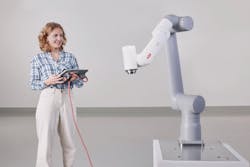Automation Insights: The State of Industrial Cobots
Collaborative robots may still be viewed as a relatively new automation technology in industry, but in the past decade, these cobots have transformed industry not just in terms of boosting throughput, quality and safety, but in helping industry deal with ongoing worker shortages. To get an expert’s view of industrial cobots as we head into 2024, Automation World connected with Tim Paton, general industry segment manager at ABB Robotics.
AW: What are the key differentiators between collaborative robots and traditional industrial robots?
Paton: There are two main benefits collaborative robots (cobots) have provided to the robotic automation landscape. The first is to create an easier robot variation to integrate and maintain than traditional industrial robots. The second is to create a shift in the perception from a robot being a machine that needs to be enclosed in a protective barrier so it cannot harm people who work in the general proximity, to that of a piece of equipment that helps accomplish a task with limited safety risks.
Cobots were created to allow robots and people to work closely together safely. Cobots have the ability to detect external forces and stop safely when making contact with a person or object, allowing man and machine to work simultaneously on different aspects of, say, a welding application—significantly increasing welding throughput and overall process productivity. This cobot technology enables safe collaboration to be achieved without the space and cost associated with installing protective fencing or other physical barriers.
Before cobots, industrial robot cells were big machines that needed to be kept behind secure safety fencing, requiring a time-consuming process to interrupt production and enter a cell to ensure the robot didn’t hurt the operator. Robots were complicated machines and difficult to program, resulting in the need to hire and pay a system integration company to get the equipment working. Once it was working, it was equally challenging to keep it running due to the complexity of the internal workings of the software.
This meant that industrial robots were most suited to larger companies that had the resources to hire dedicated robot programmers and operators. As time went on, people with these skills were hard to find and, if they left the company or were absent for any reason, production levels fell off for periods of time.
Because cobots are designed to allow the robot and people to interact easily, the complex process involved with entering a robot work cell has been eliminated. And in many instances, protective barriers are not necessary. Also, the programming software that has been developed for cobots has been greatly simplified. Some functionality was abandoned with the simplified programming, but the simplicity gained meant that a company didn’t need a highly skilled programmer to get a cobot up and running. And, because implementation and maintenance costs are reduced, many other processes that were not considered financially and functionally viable for robots are now justifiable for an investment in automation. As a result, because they are straightforward to program, deploy and use, collaborative robots have lowered barriers to automation for first-time users and small to medium enterprise (SMEs).
AW: What types of tasks are best suited for collaborative robots in a manufacturing setting?
Paton: Cobots are ideally suited for applications that require an operator to frequently interact with the robot; for example, in the case of high-mix, low-volume production runs. The reduced time it takes for an operator to enter the collaborative robot cell, whether behind a fence or not, makes changeovers far quicker and less disruptive. Also, for tasks that require a lot of path programming, a cobot can be a good fit due to the simplified programming methods that have been recently developed.
Setup is made easy with recent programming advancements like ABB’s Wizard Easy programming software, which allows even non-specialists to quickly automate applications by manipulating simple graphical command blocks rather than writing complex programming code. This Wizard Easy programming software is built on the concept of Blockly, an open-source visual coding method that presents programming language or code as interlocking blocks. By using this simplified approach, Wizard Easy allows users to program cobots without prior knowledge of any robot programming language. A user can simply drag and drop these functions on the FlexPendant, see the results immediately and adjust the robot’s actions within seconds.
AW: Are there specific industries or applications where collaborative robots have seen the most significant impact or adoption?
Paton: ABB’s recently introduced GoFa 10 and GoFa 12 cobots offer tool center point (TCP) speeds of up to two meters per second with 0.02-millimeter repeatability. With IP67-certification against moisture and dust ingress, they extend the benefits of fast and accurate collaborative robotics to new industrial applications, automating demanding tasks such as machine tending, welding, parts handling, polishing, assembly and even lighter product packaging and palletizing.
One of the initial advantages of collaborative robotic welding systems that SMEs appreciate is the lower all-in cost compared to traditional robotic welding cells. Not only does the cobot typically cost less than a heavier duty six-axis robot, but the elimination of safeguarding equipment, positioners and space allocation renovations provide additional savings. The ability to install and operate the cobot systems without hiring additional staff is another investment savings.
Collaborative robots can significantly improve weld quality by providing precise, continuous and steady weld motion for smoother, stronger seams. They also improve quality by producing longer welds without the need for multiple stops and starts inherent to manual welding.
The GoFa 10’s 1.62-meter reach—14% more than others in its class and enough to cover U.S. pallets—makes it ideal for palletizing applications as well. A cobot’s ability to detect external forces and stop safely when making contact with a person allow cobot palletizing cells to be installed in smaller spaces than traditional industrial robot palletizing cells.
Cobots are also well-suited for assembly and machine tending applications.
AW: What challenges or barriers do companies typically encounter when integrating collaborative robots into their production lines?
Paton: The biggest barrier to any implementation of automation is perception and buy-in by the employees. If employees are accepting of the solution and see it as making their jobs and lives easier, then the implementation is easy. If the employees are fearful of the new technology or just change in general, then the implementation will be much more difficult.
Another challenge is to thoroughly define the structure and motion of the task that a newly installed cobot is to do on the production floor, especially if it is something that a human has traditionally done. People accomplish complicated tasks very easily, and when you automate these tasks it is very easy to miss when an operator re-orients a part or looks to see what side of the part has a specific feature that allows proper positioning. It is very important to talk through the process with an “expert” so that the cobot adeptly and accurately accomplishes the desired task.
AW: There have always been concerns about robots taking jobs away from humans and that’s certainly the case with cobots. How are you seeing cobots affect the workforce? Are there still significant concerns about job displacement?
Paton: Over the past three decades, the biggest threat for job replacement has been off-shoring. A lot of good paying jobs have gone to lower-cost countries due to the difference in worker wages. The U.S. is not a place where labor costs are low. Cobots—and robots in general—are allowing more manufacturing jobs to be re-shored. With the workforce shortages here in the U.S., the increase in efficiency that robots offer is making U.S. manufacturers a more competitive source of parts and materials for many companies.


